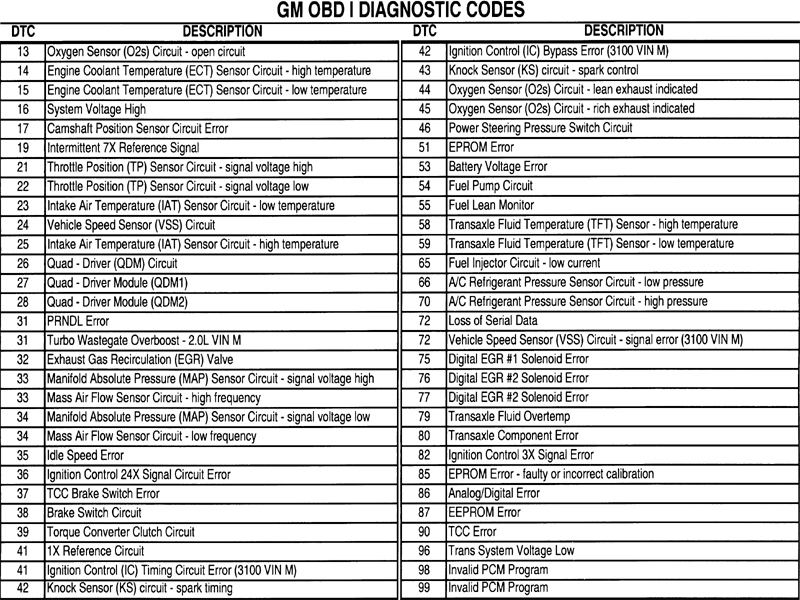Deciphering Your Chevy Colorado: Understanding Error Codes
Imagine this: you're cruising down the road in your Chevy Colorado, enjoying the ride, when suddenly, a warning light flashes on your dashboard. A sense of unease sets in. What does it mean? This is where understanding your truck's diagnostic trouble codes, commonly known as Chevy Colorado error codes, becomes crucial.
These codes are your truck's way of communicating a potential problem. They act as a digital language, offering clues about what might be amiss under the hood. From minor glitches to more significant malfunctions, these codes offer a starting point for diagnosis and repair. Deciphering these cryptic messages can save you time, money, and potential headaches down the road.
Chevy Colorado error codes, like those in other modern vehicles, emerged with the advent of onboard diagnostics (OBD) systems. These systems constantly monitor various components and sensors within your vehicle, looking for deviations from normal operating parameters. When an anomaly is detected, the system generates a specific code corresponding to the issue. These codes are stored in the vehicle's computer and can be retrieved using a diagnostic scanner.
The importance of these diagnostic codes cannot be overstated. They provide a valuable tool for both DIY mechanics and professional technicians. Instead of relying on guesswork, you can pinpoint the source of the problem with greater accuracy. This targeted approach eliminates unnecessary repairs and helps ensure you're addressing the root cause of the issue, not just treating the symptoms.
While these codes are incredibly helpful, it's important to remember that they don't always tell the whole story. They provide a starting point for diagnosis, not a definitive diagnosis. A single code can sometimes have multiple possible causes. For example, a code related to engine misfires could be caused by faulty spark plugs, a clogged fuel injector, or a vacuum leak. Further investigation is often necessary to pinpoint the exact cause.
One benefit of understanding Colorado error codes is cost savings. By identifying the issue early, you can potentially avoid more costly repairs down the line. For instance, addressing a minor sensor malfunction promptly could prevent it from escalating into a major engine problem. Another advantage is improved vehicle performance. Diagnosing and fixing issues indicated by the codes can restore your truck's optimal running condition. Finally, understanding these codes gives you greater control over your vehicle's maintenance. You're not entirely reliant on a mechanic's interpretation; you can actively participate in the diagnostic process.
A simple action plan for dealing with Chevy Colorado error codes involves using an OBD-II scanner to retrieve the codes, researching their meaning online or in a repair manual, and then proceeding with troubleshooting based on the likely causes. For instance, if you encounter a code related to a faulty oxygen sensor, you could start by inspecting the sensor for damage or corrosion. A successful example would be identifying a loose gas cap as the cause of an evaporative emissions code, a simple fix that saves a trip to the mechanic.
Advantages and Disadvantages of Using Error Codes
| Advantages | Disadvantages |
|---|---|
| Early problem detection | Codes don't always pinpoint the exact cause |
| Cost savings | Requires a diagnostic scanner or professional help |
| Improved vehicle performance | Misinterpretation of codes can lead to unnecessary repairs |
Best Practices for Using Error Codes:
1. Invest in a reliable OBD-II scanner.
2. Research the codes thoroughly before attempting repairs.
3. Address the most likely causes first.
4. Consult a repair manual for specific troubleshooting steps.
5. If unsure, seek professional help.
Frequently Asked Questions:
1. What does a P0300 code mean? (Multiple cylinder misfires)
2. How do I clear error codes? (Using an OBD-II scanner)
3. Can I drive with the check engine light on? (Depends on the severity of the code)
4. Where can I find information about specific codes? (Online databases, repair manuals)
5. What is an OBD-II scanner? (A device used to retrieve and clear error codes)
6. Do all Chevy Colorados use the same error codes? (Generally, yes, but specifics can vary by model year)
7. How often should I check for error codes? (Periodically, or when the check engine light illuminates)
8. Can I fix all issues indicated by error codes myself? (Some, but others require professional expertise)
Tips and Tricks: Keep a record of the codes you encounter and the repairs performed. This history can be valuable for future troubleshooting.
In conclusion, understanding Chevy Colorado error codes is essential for any owner. These codes provide a window into your truck's inner workings, allowing you to address potential problems proactively. From cost savings and improved performance to greater control over your vehicle's maintenance, the benefits are undeniable. While interpreting and addressing these codes might seem daunting at first, with the right resources and a little patience, you can confidently navigate the world of automotive diagnostics. Take the time to learn the language of your truck, and you'll be rewarded with a smoother, more reliable driving experience. Empower yourself with knowledge, and don't let those flashing lights intimidate you. Start exploring the resources available and become familiar with the common codes for your Colorado. You’ll thank yourself in the long run.
Choosing faith future your guide to catholic high schools in roswell ga
Unlock bing search traffic your bing webmaster tools login guide
Celebrate feline friends a guide to national cat day







